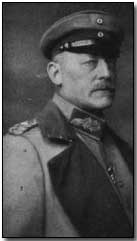Who's Who - Oskar von Hutier
 General Oskar von Hutier
(1857-1934) served as a boldly effective field commander during World War
One and was renowned for his efficient use of so-called infiltration
tactics.
General Oskar von Hutier
(1857-1934) served as a boldly effective field commander during World War
One and was renowned for his efficient use of so-called infiltration
tactics.
Hutier's family background was military through and through. His grandfather fought with Napoleon and his father saw action in the Franco-Prussian War of 1870-71; Erich Ludendorff, the German army's Quartermaster General was a cousin.
Hutier was marked out early in his career as a highly promising military officer by Paul von Hindenburg while Hutier trained at the Lichterfelde cadet school. Emerging from cadet school he entered the General Staff Corps and spent his time shuttling back and forth between staff and troop commands.
With the First World War underway Hutier served initially with von Bulow's Second Army during the First Battle of the Marne, commanding the 1st Guard Infantry Division. April 1915 saw Hutier posted to the Eastern Front to take command of XXI Army Corps under Eichhorn's Tenth Army.
In January 1917 Hutier was assigned to command of Army Section 'D' on the Duna River south of Riga, preparatory to being handed command of Eighth Army three months later. It was while commanding Eighth Army that Hutier established the reputation upon which his fame is based.
On 3 September 1917 Hutier's forces captured Riga while demonstrating the German army's new infiltration tactics. Although Hutier played no role in the development of such tactics (which were based upon British and French tactics) his prominent and wide scale use of them caused the British to dub them 'Hutier tactics' - the name remained. On 6 September Hutier was awarded the prestigious Pour le Merite for his successful efforts.
One month after capturing Riga his units succeeded in taking the Baltic Islands in what was the only successful amphibious undertaking of the war.
Transferred to the Western Front Hutier was charged with spearheading the great German spring push of March 1918 in command of the newly-created Eighteenth Army. Consequently on 21 March Hutier's five Corps and 27 divisions opened the offensive and made spectacular initial gains.
Once again deploying infiltration techniques his forces captured some 50,000 prisoners and advanced a remarkable 60km, largely in opposition to British General Sir Hubert Gough's Fifth Army. His forces moved so quickly that German flanking forces trailed far behind in his army's wake.
Promptly awarded the Oakleaves to supplement his Pour le Merite two days later by the Kaiser, Hutier's advance was ultimately slowed and then brought to a standstill by increasingly effective British and French resistance, allied to supply difficulties across the old Somme battlefield.
Hutier renewed his offensive at Matz in June 1918 but was quickly stifled by a highly effective French defence. Following this his forces were thrown on to the defensive for the remainder of the war.
With the armistice Hutier led his forces back across the Rhine to Germany. He maintained that the German army had not been defeated on the battlefield but were 'stabbed in the back' by political forces at home (a refrain taken up by other prominent commanders including Ludendorff).
He resigned from the army in January 1919 and accepted the presidency of the German Officers League until January 1934. He died that year aged 77.
A 'Woolly Bear' comprised a German shrapnel shell, which burst with a cloud-like explosion.
- Did you know?
